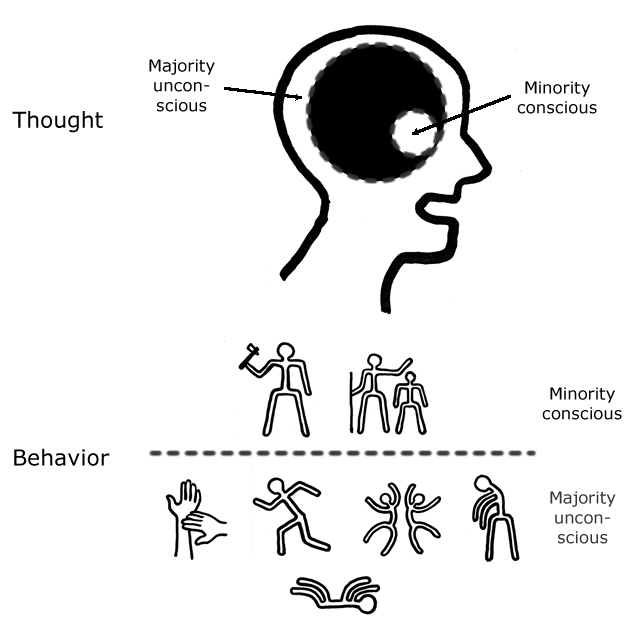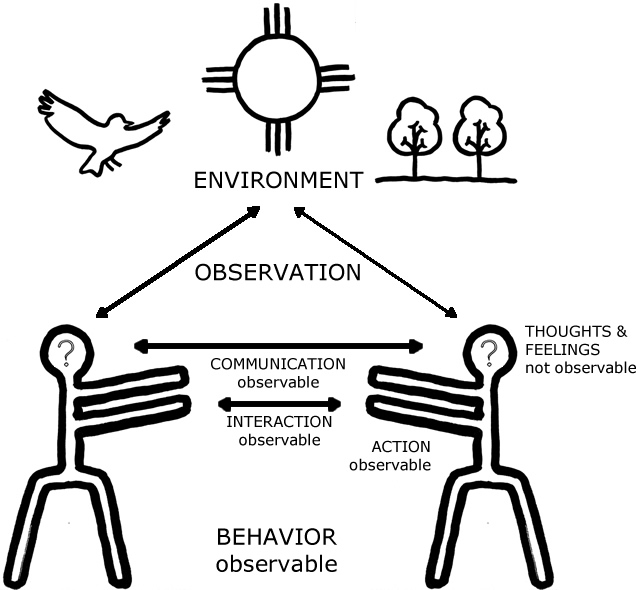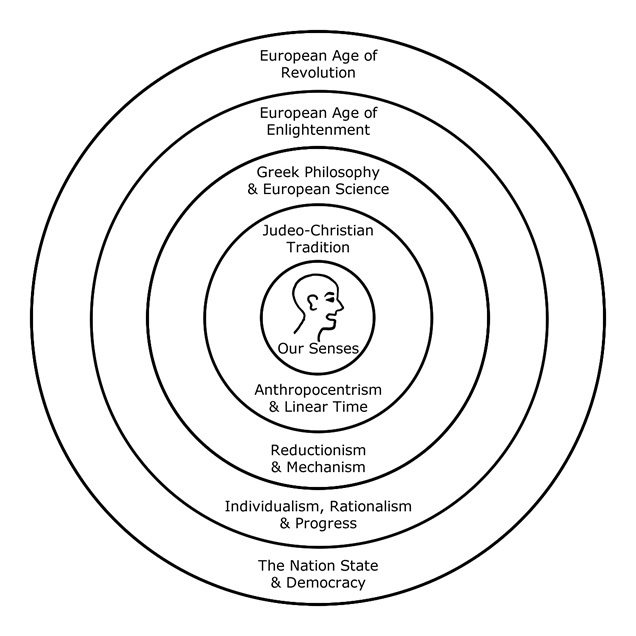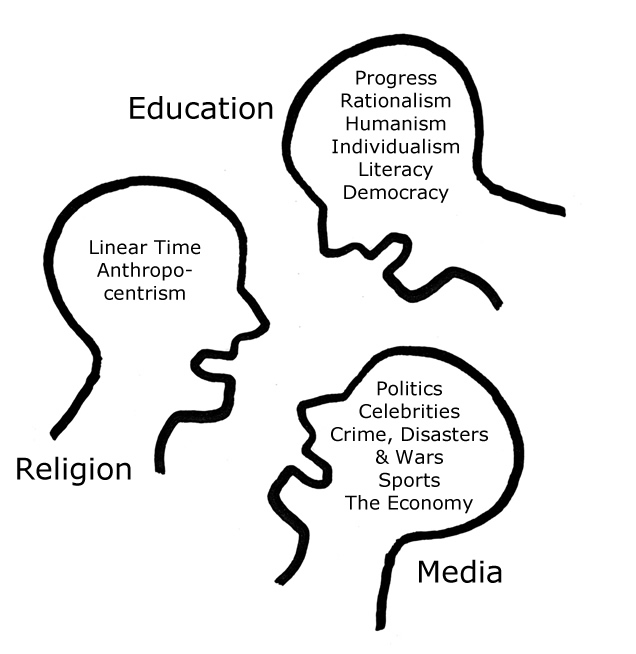|
|
 |
 |
 |
 |
 |
|
|
|
 |
|
What are the limitations of our knowledge? Is our dominant view of the world missing anything? How is our view of the world biased by our history, culture, and technology?
Our behaviors, including the way we habitually observe, feel, think, and talk about our lives and the world around us, reveal hidden biases – learned, accumulated, and adapted throughout our lives – that may be called worldviews, belief systems, or value systems.
Although our success is largely dependent on these habitual ways of seeing, organizing, and reacting to the world, we are mostly unaware of them.
Pictures of Knowledge give us a way to bring these unconscious biases out in the open and work toward agreement on matters that are important to all of us. |
|
 |
|
What We Don't Observe

Wherever we are, we exist in a sensory environment with boundaries beyond which we don't see, hear, smell or feel.
Even within our immediate environment, many things are hidden from us.
In general, what we don't observe, and what we don't even know, may be called mystery.
"There is no escape from mystery. It is the character of our being." Black Lamb and Grey Falcon, Rebecca West |
|
 |
|
Top
|
|
 |
|
What We're Unconscious Of

We're all familiar with the experience of doing something unconsciously. We're also aware that our bodies follow their own agenda, keeping us alive without us having to think.
Most of our thought and behavior is unconscious. Without this unconscious thought and behavior we wouldn't survive.
Thus, our powers of reason are limited to the minority of thought and behavior that we are conscious of.
Human knowledge is very limited, whereas what we don't know – mystery – is infinite.
Some people say that specialist experts can make the unconscious conscious, make the unknown knowable, and learn about everything by means of science.
By contrast, some Native American peoples honored the unknowable, and the limits on human knowledge, in their concept of the Great Mystery.
"Sometimes this kind of curiosity, which is the very crux of science, becomes almost an addiction. Instead of luxuriating in the pure "whatness" of things, it seems necessary to ask "how" and "why," even if the answers are unimportant and the mystery is beautiful in itself. Intriguing as they are, the questions, theories, studies, analyses, and explanations can obscure as much as they reveal, like scores of tails pinned all over the donkey until its shape and wholeness disappear." The Island Within, Richard Nelson |
|
 |
|
Top
|
|
 |
|
Hidden Thoughts & Feelings

When we communicate with other people, we may point to things in our sensory environment which are mutually observable, or we may talk about things that we are thinking or feeling, which are not observable by anyone else.
Other people have no way of being sure of our thoughts or feelings. We are much more likely to reach agreement when we can talk about things that are mutually observable.
|
|
 |
|
Top
|
|
 |
|
Unconscious Biases

Cultural conditioning has accumulated for millenia in our society, like the layers of an onion, distorting the way we see and experience the world and creating a "veil of illusion" that prevents us from experiencing the world fully and accurately. Inside these layers of illusion, our awareness, our consciousness, our potential, is hidden like the innermost Russian doll.

In addition to the conditioning of our society, everything we know, everything we say to other people, is shaped by our personal experience, which is different from everyone else's. Our different backgrounds, and the different roles we play in society, lead us to picture the world, and to have feelings about it, that are personal. This picture of the world, and the feelings associated with it, may be called our worldview, belief system, and value system. Other common terms are mental model and cognitive framework, but none of them adequately connote the complexity and mystery of what may be going on inside us.
When we need to share our thoughts or feelings, we can improve our chances of being understood if we use observable representations of what is inside us, for example pictures that represent our thoughts or feelings.
But none of us is fully aware of the personal worldview, belief system, and value system that shape our thoughts and feelings. Pictures of Knowledge give us a way to bring these unconscious biases out in the open and work toward agreement on matters that are important to all of us.
|
|
 |
|
Top
|
|
 |
|
Technological Filters

Most of our information about the world does not come from direct observation, but rather from a combination of instrumental observation and communications media, ending up on the screens of our devices.
Instruments such as cameras, microphones, remote sensing devices, and media recorders produce information but not knowledge, because they filter out the complete sensory context that makes information meaningful, leaving only a partial record of the phenomena.

This partial record is then further filtered and distorted through communications networks and media. The "signal" is distorted by network "noise" and impoverished by transmission losses, and the distorted signal is edited, perhaps multiple times, either programatically or subjectively by culturally conditioned human editors, with the goal of fitting the impoverished and distorted simulacrum of the original phenomenon into a culturally conditioned narrative for us, the audience.
The result is misinformation, rather than knowledge of the world.
"Low-context culture emphasizes literacy and rationality....Other levels of awareness are underdeveloped or dormant. Ways of perceiving are restricted primarily to a linear system of thought....Low-context cultures use primarily mathematical models to explain nature and environment. People are highly individualistic and somewhat alienated in contexts that require little involvement with other people. Low-context culture is fragmented rather than integrated, and people live more and more like machines....Persons in low-context cultures are prone to use manipulation to achieve their goals and are also prone to be manipulated. Failures are blamed on the system. In times of crisis, individuals expect help from institutions, not from persons." Beyond Culture, Edward T. Hall
"Direct sensuous reality, in all its more-than-human mystery, remains the sole solid touchstone for an experiential world now inundated with electronically-generated vistas and engineered pleasures; only in regular contact with the tangible ground and sky can we learn how to orient and to navigate in the multiple dimensions that now claim us." The Spell of the Sensuous, David Abram |
|
 |
|
Top
|
|
 |
|
Talking With Abstractions

All of our words, except for some proper names and pronouns we use while pointing at visible things, are abstractions that are likely to mean something different to everyone.
The color "red" is an abstraction encompassing infinite hues and tones; "love," "peace," "environment," "society" – even proper nouns like "America" are vague and ambiguous, particularly in communications between people in our diverse, mobile societies who may have radically different origins and experiences, and hence different worldviews, belief systems, and value systems.
Communicating with words alone, we risk confusion and misunderstanding, and even worse, we may trigger divisive emotional reactions in our audience.
"A picture is worth a thousand words" – this folk expression captures the way in which pictures can make the abstract concrete, giving us something to point to as we communicate.
|
|
 |
|
Top
|
|
 |
|
Previous | Next |
|
|